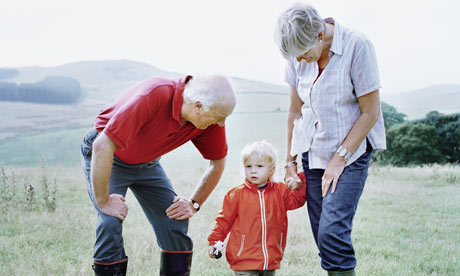 |
| Is Wales getting older? Are parts of Wales getting younger even? It's a mixed bag. The 2011 census throws up surprises and not-so big surprises. (Pic : The Guardian) |
- Census 2011 : What's stunting Welsh?
- Census 2011 : Losing our religion?
- Census 2011 : National Identity & Ethnicity
- Census 2011 : Disability, Carers & Health
- Census 2011 : Qualifications
Next stop on the 2011 "census tour", and it's one of the big ones. Only two more areas to go after this. Is Wales getting older? What implications will changing age demographics have on Welsh public services? And how does all this fit in with previous posts – like those on the Welsh language and disability?
I'm not going to bother breaking these figures down by gender, as that would complicate things further. You'll all know that women live longer on average than men anyway.
The Welsh Age Profile
In 2011, the mean age in Wales was 40.6, which isn't too different from the median age (41). So people aged 41 in Wales are at the "half way point" in terms of age if you split the population into two equal groups. I couldn't find any similar figures for 2001, so I can't tell how this has changed, but I suspect it's slightly upwards. You'll probably agree once you've read the rest of this.
Wales is slightly older than England (mean 39.3, median 39) and the only English region older than Wales was the South West of England (mean 41.6, median 42). In Cornwall, the figures were a mean of 43.3 and a median of 45.
 |
| The median age of the resident population in 2011 (Click to enlarge) |
Cardiff is significantly "younger" than the rest of Wales, with a median age of 33. Swansea (39) and Newport (38) are distant third and second places. The south Wales valleys are generally around the Welsh average, with the median age ranging between 40-42.
Conwy is the "oldest" county in Wales, with a median age of 46 and the highest mean of 44.6. Powys (median 46, mean 43.9), Anglesey (median 45, mean 43.4) and Monmouthshire (median 45, mean 43) closely follow .
In Y Fro, somewhat surprisingly, Gwynedd (median 42, mean 41.6) and Ceredigion (median 42, mean 41.7) are not really that different from the Welsh average. I would've expected Ceredigion at least to be "older", but that's probably the impact of the universities dragging the averages down. If you removed students from those two counties, then I suspect Y Fro would probably be significantly "older" on average than the figures suggest.
The Retired and Elderly (Aged 65+)
In 2011, 18.3% of the Welsh population were aged 65 or over. What will perhaps surprise you, is that it's only risen by 0.9% between 2001 and 2011. Although it's still 1 in 5 of the population near enough, I was expecting higher.
 |
| Resident population aged 65+ in 2011 (Click to enlarge) |
Once again, there are differences between Welsh local authorities. Cardiff has significantly fewer pensioners than any other part of Wales (13.2%). Newport, the Gwent Valleys and Merthyr Tydfil are a cluster of local authorities with fewer pensioners too, ranging between 16-17% of the population. The likes of Bridgend and Swansea (both 17.9%) follow close behind.
In the north and west though, there's clearly a much greyer population, but we probably already knew that anyway. Conwy is way out ahead of everywhere else with nearly a quarter of the population (24.4%) aged 65+. Powys (22.8), Anglesey (22.4%) and Pembrokeshire (21.8%) come closest to that. What is noticeable though is that Wrexham (17%) and Flintshire (17.6%) have South Walian low levels of pensioners.
In terms of how things have changed compared to 2001, Anglesey has seen by far and away the sharpest increase in pensioners (+3.5%), closely followed by Powys (+2.9%) and Monmouthshire (+2.8%).
What is a little surprising is that – Anglesey aside - things haven't changed very much in north Wales. It's mid and west Wales (and Monmouthshire) which is seeing a big greying of the population.
 |
| Change in the percentage of residents aged 65+ between 2001-2011 (Click to enlarge) |
You could even say that south Wales - and that's where most people live, especially Cardiff and Swansea - might not have aged as quickly as the government and local authorities are concerned about.
In terms of specific age groups, although the numbers of 60-74 year olds increased nationally by around 2.1% compared to 2001, there's a drop off at ages 75-84, presumably because that's the age group where most people die naturally.
2.4% of the population of Wales were aged 85+ in 2011 - a rise overall of 0.4% on 2001. Living that long probably comes down to luck and genetics – including the length of your telomeres if you want to get technical - as there's no set pattern across Wales. Torfaen, for example, has seen the same percentage growth of 85-89 year olds as Ceredigion (+0.5%).
Children & Young Adults
Some 45.2% of the Welsh population are "adults", which I'm defining as aged between 30-64. However, the number of 30-45 year olds fell by 2.3% between 2001 and 2011 – the sharpest fall of any census age group – and there were noticeably sharper falls in rural local authorities like Powys, Monmouthshire and Ceredigion.
For the sake of brevity (stop laughing), I'm not going to look into that. What I am going to look at though are younger age groups, namely school age children (5-17) and young adults (18-29). The young adult group will be particularly interesting for economic, cultural and demographic reasons.
School age children
Overall, while the percentage of pre-school children (aged 0-4) hasn't changed at all nationally from 2001, the percentage of school age children fell by 3.4%. Carmarthenshire aside, it's Y Fro counties that have the lowest percentages. Ceredigion had the lowest at 11.4%, followed by Anglesey and Gwynedd (both 12.8%).
 |
| Resident population aged between 5-17 in 2011 (Click to enlarge) |
 |
| Change in resident population aged between 5-17 (2001-2011) (Click to enlarge) |
Somewhat surprisingly, Cardiff (12.9% ) and Swansea (13%) also had lower than average school age populations. That's probably a distortion caused by a larger number of people overall.
The Gwent area and the Vale of Glamorgan had the highest school age populations, with Newport having the highest percentage nationally at 15.1%. Many of the south Wales valley authorities also had above average numbers of children.
In terms of how it's changed, it's a fairly uniform fall across Wales. Most local authorities saw a fall of around 3-4% in their school age populations, with the joint sharpest falls in Merthyr Tydfil and Blaenau Gwent (-4.7%).
In Y Fro, although the falls in the school age population aren't that different to the rest of the country, because of smaller total populations in authorities like Anglesey and Ceredigion, the effect of the "loss of the young" will likely be amplified much more than in the urban south or north east.
Young adults
The number of young adults on the other hand has increased compared to 2001 – a national rise of 1.8%. 15.8% of the Welsh population were aged between 18 and 29 in 2011.
Cardiff (24.1%) and Swansea (18.4%) – as you might expect – had some of the highest percentages of young adult residents. What was a little surprising is that Ceredigion had the second highest nationally at 21.2%. I think the reason for that's obvious – Aberystwyth & Trinity St David's Universities. Gwynedd also had a relatively high number of young adults at 16.8% of the population.
 |
| Percentage of the resident population aged between 18-29 in 2011 (Click to enlarge) |
 |
| Change in resident population aged 18-29 between 2001-2011 (Click to enlarge) |
In terms of low levels, you've got to point to rural areas of Wales like Powys (11.4%), Anglesey (12.4%), Pembrokeshire (12.6%) and the lowest in Monmouthshire (11%). All of those authorities also lack a university, it's worth pointing out.
In terms of how these numbers have changed on 2001, what's fairly obvious is that Cardiff is by some way acting as a youth magnet with a gain of 4.1%, followed by Newport (+3.1%) and Ceredigion once again (+3.1%). Merthyr Tydfil also saw a big rise of (3.1%). Is that a hint that young adults priced out of Cardiff might be moving north? Or is it just a natural demographic shift?
Some local authorities though had fairly low levels of growth. Flintshire almost flat lines at +0.2% , similarly many north Wales authorities, with the exception of Gwynedd (+1.9%).
Other southern local authorities you would've expected to see sharper growth didn't. Bridgend's young adult population only grew by 1.1%, as did Neath Port Talbot. While Rhondda Cynon Taf only saw a 1% increase.
Because there's so much here that needs to be looked into, this post has been split. The second part will be posted tomorrow and will revisit some other things – like the Welsh language – as well as what all this could mean for the Welsh economy, politics and public services.












That Swansea and Cardiff have lower than average figures for those of school age is probably due to the numbers of students, and others of that age group, moving to these cities. Surely mirrored in the rise in the percentages of young adults. This would also explain why Ceredigion is the lowest of all.
ReplyDeleteThanks, Jac.
ReplyDeleteI suspect what you say is probably right. But 11% of the population in Ceredigion (~7,000 children) is still much, much less in terms of sheer numbers than 13% of Swansea (~31,200 children).
This could have big long-term implications on things like planning for school places somewhere more sparsely populated like Ceredigion (let alone considering the impact on WM education) compared to a larger urban area like Swansea. I'll be coming back to this is more detail tomorrow anyway.
Blog Menai looked at similar statistics:
ReplyDeletehttp://www.oclmenai.blogspot.co.uk/2013/03/taenlen-arall-yn-ymwneud-ar-cynulliad.html
Main difference the he looked at the over 20s, and compared Welsh Speakers to non Welsh Speakers.
The headline figure I guess was that for people over 20, Welsh Speakers are for the first time ever on average younger then non-Welsh speakers.
I'll be covering some of that in the next post, Ioan. Which should be up shortly.
ReplyDelete